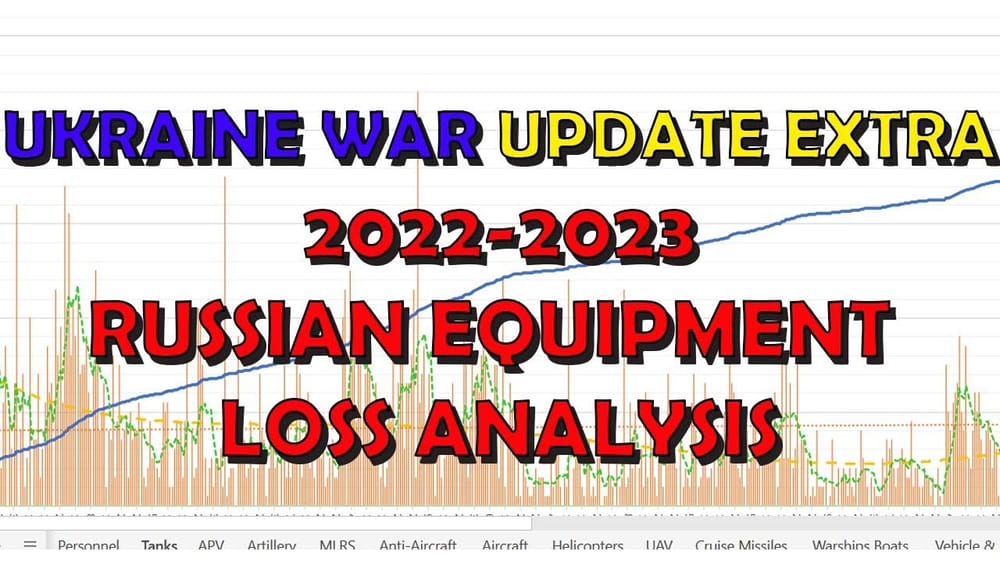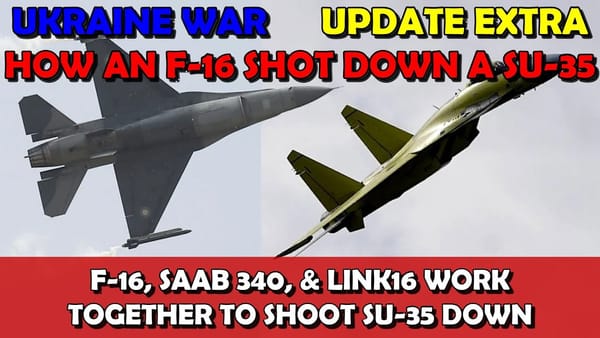Ukraine War Upd. EXTRA: 2022-2023 Russian Equipment Loss Analysis
Table of Contents 📖
"So the Ukrainians are just in a much better position. I mean, this is my favorite graph because that is a steep line, and that is just a massive amount of metal that has been destroyed."
Hello Team
🎦 00:00-01:18⏩
Jonathan welcomes everyone to the channel and introduces the focus of today's extra video which is an analysis of the Russian equipment losses over the course of the war so far. He explains that the data is from "Dell's excel spreadsheet" and thanks Dell profusely for his efforts in making this available. Jonathan stresses that this is just one side of the story and that the data should be treated with caution but that from his reporting he believes the trends are broadly accurate.
Return to top⤴️
Methodology
🎦 01:19-02:32⏩
Jonathan explains how he uses the spreadsheet to do his analysis by comparing the steepness of the blue line (which represents total losses and never goes down) against the yellow dotted trend lines (which can go up and down). The steeper the lines, the worse the losses for that period.
Return to top⤴️
Russian Personnel Losses
🎦 02:32-05:11⏩
Jonathan begins his analysis by looking at Russian personnel losses. He points out the steep gradients for October, November, December 2022 (peaking at 1380 in a single day in October) which reflects the losses incurred during the Ukrainian counter offensives in Kharkiv and Kherson. He compares this to the period April-August 2023, where losses were lower and highlights how Russian losses appear to be higher when attacking rather than defending.
Return to top⤴️
Russian Tank Losses
🎦 05:11-08:44⏩
Jonathan notes the initial heavy losses of tanks at the start of the war when the large Russian columns were destroyed, followed by a further spike in September/October 2022 (during the Kharkiv counteroffensive) and then again from October 2022 onwards. He points out how the gradient of Russian tank losses is now consistently steep and how the Russians are now losing significant numbers of tanks on a daily basis when attacking - peaking at 55 in a single day.
Return to top⤴️
Russian Armoured Personnel Vehicle Losses
🎦 08:44-10:34⏩
Again, Jonathan notes the initial heavy losses at the start of the war followed by the now familiar pattern of heavy losses from October 2022 onwards for APCs, IFVs, MRAPS. Again, he links this to the Russian attacks from October 2022 onwards and how these losses represent "incredibly suicidal activity". He points out how the Russians are faring much better defensively but questions (from a Ukrainian perspective) whether it makes more sense to let the Russians attack and inflict losses than to attack themselves.
Return to top⤴️
Russian Artillery Losses
🎦 10:34-14:59⏩
For the first time, a different pattern emerges. Jonathan notes how artillery losses were high for the Russians during the Ukrainian counteroffensives but have become even steeper since the Ukrainians switched to an attrition strategy - focusing on degrading Russian artillery. He believes that this has been highly effective, as evidenced by the recent decrease in the trendline for artillery losses. This could indicate that the Russians have fewer artillery pieces to target, and may be running out of artillery shells. Jonathan cites reports that the Russians are only firing 10,000 artillery shells per day, compared to 40-60,000 per day earlier in the war.
Return to top⤴️
Russian MLRS Losses
🎦 14:59-16:57⏩
Jonathan observes that the trend for Russian MLRS losses is too "jaggedy" to draw firm conclusions due to the relatively small numbers lost, but that losses have been more consistent since the Ukrainians switched to an attrition strategy last summer.
Return to top⤴️
Russian Air Defence System Losses
🎦 17:06-18:27⏩
The trend for Russian Air Defence Losses is similar to that of the MLRS. Losses are consistent but with spikes. Jonathan notes the spike in losses during the Ukrainian counteroffensives, and how losses have remained fairly consistent since, although he speculates that the rate of Russian losses could slow down as the Ukrainians start "running out of targets".
Return to top⤴️
Russian Aircraft Losses
🎦 18:27-21:02⏩
Jonathan observes that Russian aircraft losses were very high in the early stages of the war because they failed to properly suppress Ukrainian air defences. As a consequence, they were forced to scale back their operations and eventually started using glide bombs to avoid coming within range of Ukrainian air defences. He notes how losses have increased somewhat in recent weeks and speculates that this is a result of improving Ukrainian air defences.
Return to top⤴️
Russian Helicopter Losses
🎦 21:02-22:29⏩
Jonathan points out how there have been hardly any Russian helicopter losses in the past 6 months. He attributes this to the fact that the Russians are using them far less than they were, possibly as a result of losing a number of helicopters during the Ukrainian counter offensives. Jonathan also speculates that the Russians may be reluctant to use them because Ukrainian air defences are now capable of shooting them down.
Return to top⤴️
Russian UAV/Drone Losses
🎦 22:29-24:59⏩
Jonathan explains how the losses here mostly refer to Iranian Shahed drones and how the spikes in the numbers are likely to represent deliveries from Iran. However, he also notes that Russia may now be producing its own. He points out how the use of Shahed drones has increased significantly in December, in conjunction with a spike in the use of cruise and ballistic missiles. He questions why Russia launched a large drone wave attack on 28/12/2023 without a simultaneous cruise missile attack, and speculates that they may no longer have enough cruise missiles to conduct such an attack. He reasons that Russia is holding on to its remaining cruise missiles and is therefore also limiting the use of Shahed drones given that the primary purpose of the latter is to deplete Ukrainian air defence stockpiles, paving the way for cruise missile strikes.
Return to top⤴️
Russian Naval Losses
🎦 24:59-25:20⏩
Noting how Russia has had problems in the Black Sea recently, Jonathan explains that it's difficult to draw conclusions about Russian naval losses based on this data set as these are too infrequent.
Return to top⤴️
Russian Vehicle & Fuel Tank Losses
🎦 25:20-27:43⏩
Jonathan highlights the upwards trend in Russian vehicle and fuel tank losses since the start of the Ukrainian counteroffensives and how this has continued even though the counteroffensives have ended. He links this to the effective use of FPV drones to destroy these targets, and in particular notes how this upwards trend contrasts with that of Russian artillery losses. He concludes that the only logical explanation for this is that the Ukrainians are still successfully targeting Russian logistics but are running out of artillery pieces to target.
Return to top⤴️
Conclusion
🎦 27:43-28:22⏩
Jonathan reiterates how the Ukrainians are now in a much better position than they were a year ago, and how the data illustrates this clearly. He is particularly impressed by the steepness of the trendline for destroyed Russian artillery pieces, and concludes that the data tells a compelling story about the war. He encourages viewers to check out Dell's spreadsheet using the link in the description and thanks everyone for watching.
Return to top⤴️



